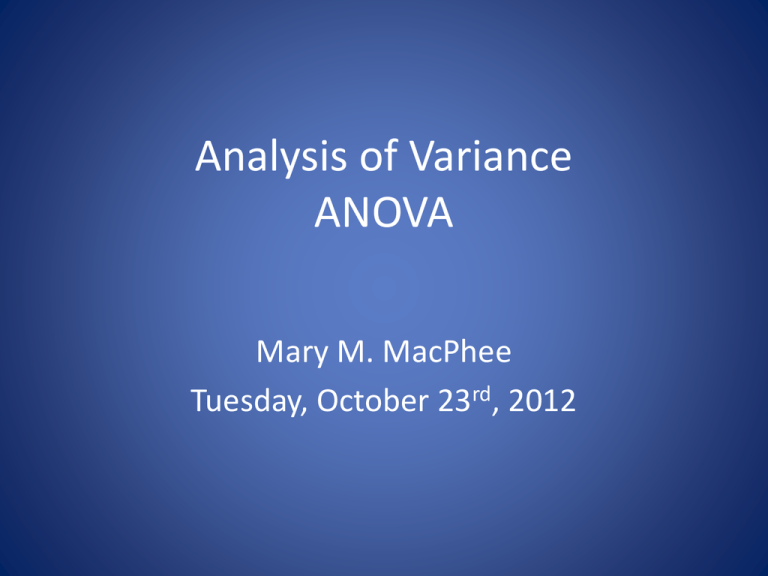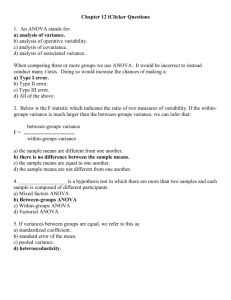Analysis of Variance (ANOVA) PowerPoint
advertisement

Analysis of Variance ANOVA Mary M. MacPhee Tuesday, October 23rd, 2012 Two main types of statistical inference 1. Estimation with levels of confidence and confidence intervals 2. Hypothesis testing using statistical significance / p-values (Vogt, p.130). Our purpose: use ANOVA or analysis of variance to test for statistically significant differences. SPSS • Running ANOVA will give you P-value • & will compute confidence intervals • ANOVA is commonly used in Psychology and Educational research • ANOVA Infers back to the general population ANOVA analysis of variance Tests for statistically significant differences between mean results of 2 or more groups. There is a comparison or analysis Differences or variances Between group means Question we are asking • How much more variance or difference is there between groups than within groups? Four Assumptions 1) Normal distribution within randomly chosen sample for DV 2) Homogeneity of variance (Levene’s) 3) Comparing independent cases 4) IV is categorical DV is quantitative Homogeneity Assumption • Levene’s test for homogeneity • Higher than 0.05 (opposite to statistical significance), When Assumptions Not Met • Welch or the Brown and Forsythe test. • Krusal- Wallis H test, (which is non-parametric, instead of using ANOVA, which is parametric) (LAERD). Inferential statistics • F-test • T2 = F (ANOVA) • t-test • 𝐹=𝑡 • most widely used tests of statistical significance • most widely used tests of statistical significance • yields p-value • yields p-value • 2-3 or more groups • 2 groups of cases • Type 1 Error decreased ANOVA • One-way ANOVA – 1 IV independent groups 3 or more • multifactor or factorial design: Two-way or Three-way ANOVA- 2 or 3 IV Ratios • Between group difference Within group difference • MSeffect MSerror explained variance unexplained variance The big F • An omnibus test; if not which • The larger the F statistic • The more likely a statistically significant finding • Smaller F statistic, then null hypothesis • …no statistically significant difference between the group means can still be important! Where is the difference? • Post-hoc, an a-posteriori (afterwards) test • Tukey HSD • Making multiple comparisons (Vogt, p.136) Strengths Robust against violations of assumptions Reduces type I error compared to multiple t-tests Ease of interpretation Greater versatility than t-tests Study multiple IV with multiple groups Weaknesses Requires approximately equal cell sizes (#). Cannot be used to establish more complex models such as can be done with regression. Requires post-hoc testing to tease out where the differences are. Let’s do it • 1)bring up data • 2)click Analyze >> compare means > one way ANOVA • 3) drag and drop ( DV) into the dependent variable box • 4) drag and drop independent variable (status) into the factor box • 5)click Post Hoc and Tukey 6) click continue • 7)click options - descriptive & homogeneity variance • 8) continue – ok Doing ANOVA /2 • Look at your descriptive statistics table, then go to multiple comparisons/ANOVA table • If statistically significant go to Tukey. Graphing • Use bar chart with standard deviation bars for Graphing ANOVA ( LAERD) References Vogt, P. (2007). Quantitative Research Methods for Professionals. Boston, MA: Pearson. Collican, H., (2004). Research Methods and Statistics in Psychology. (4th Ed.). London, UK: Hodder & Stoughton. https://statistics.laerd.com/ www.statsoft.com








